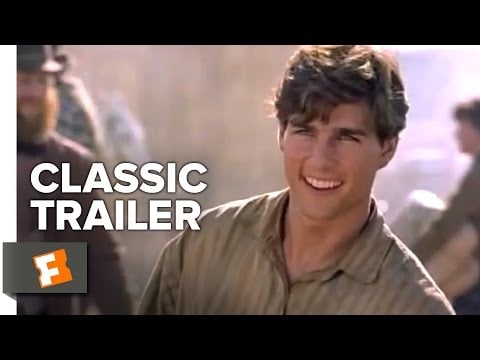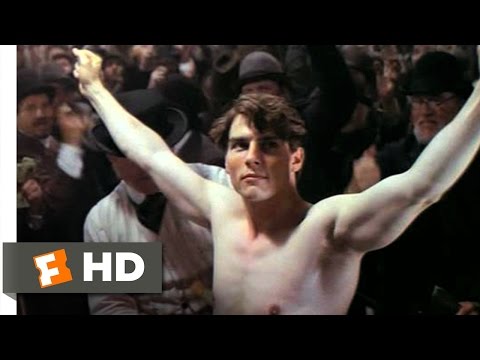Ron Howard’s “Far and Away” (1992) seemingly aims, right from the opening moments, to declare itself as the most Irish movie ever made by an American about the Irish.
It begins in Western Ireland in 1892. Mikael Salomon’s ravishing cinematography dusts the ocean waters but takes us right into a pub, where we hear drunken limericks.
We watch as three red-headed Irish brothers get into a fight. Heck, even the opening titles are green! Howard’s film declares its Irish identity so brazenly, you wonder why he bothered calling it “Far and Away” and didn’t stick with the (better) shooting title: “The Irish Story.”
One of the three brawling brothers is Joseph, played by Tom Cruise, whose father is about to die. A bedside sit takes place, in which the camera gives an elaborate POV shot of “Da” floating away into the afterlife (this showy bit of camera acrobatics is repeated much later on).
After the likes of “Splash” and a few midrange hits, Howard was clearing going for broke here and visibly enjoys painting on a big canvas.
Carrying his father’s dying words of “Without land, a man is nothing,” Joseph sets out on a mission of revenge. Joseph’s rage towards a landlord (Robert Prosky) leads to some slapstick in which he becomes bedridden and a prisoner in the land baron’s home.
Shannon, the feisty daughter played by Nicole Kidman, dreams of running off to America and takes Joseph with her as her servant. Shannon informs Joseph that, in America, they’re giving land away for free, so they set off to partake in the Oklahoma Land Rush.
“Far and Away” was written by Bob Dolman and Howard, who said it was based largely on the experiences of his immigrant great-grandparents. Howard and Salomon famously shot this is in 70 millimeter and the film looks incredible long before the characters arrive in Oklahoma.
The frame is often filled with the kind of detail you’d only capture by filming from a great distance away. Prior to “Far and Away,” Disney’s “Tron” (1982) was shot in 70mm, and Kenneth Branagh’s “Hamlet” (1996) came after this.
Seeing this on the big screen during the summer of 1992 was a memorable experience, as the film provided the kind of popcorn spectacle I’d sought after but was also exactly the kind of epic sized entertainment my father relished from his childhood.
Howard’s film takes far too long to get going, as a lumpy first act piles on too many supporting characters and incidents that keep it in neutral. Thomas Gibson is perfectly loathsome as the central villain (he’d later reappear seven years later, playing a clueless husband opposite Cruise, in “Eyes Wide Shut”) and I enjoyed the arch of Prosky’s land baron turned gleeful cowboy.
Otherwise, the film is overwritten.
After escaping a duel by pistol, Joseph and Shannon flee the country and arrive in Boston, where the film becomes a bare-knuckle boxing film for nearly half an hour. The boxing matches are great – there’s even a shot where the camera revolves around Cruise while he’s in his element punching out opponents, very similarly to the way Martin Scorsese once circled around the star in “The Color of Money” (1986).
Despite an excellent showcase for Colm Meany (as well as a quick cameo from Brendan Gleason – there’s so much Irish in this movie!) and the ample bloodshed (this portion is the reason the film is rated PG-13), “Far and Away” feels like a Disney movie. In fact, its tonally akin to the big Disney period flop of the same year, “Newsies” (the irritating character Dermody feels like a lost Newsie).
The second act concludes with the result of The Big Fight and it’s as gritty and ugly as this movie gets. As much as I like “Far and Away,” the story of two immigrants who struggle to make it in America should have been much tougher.
The story then picks up a whopping eight months later, where we find Joseph working alone in the Ozark mountains. At this point, its irritating how much the movie is dragging its feet to get to Oklahoma, since the plot was set up so clearly in the first act.
30 years after his last trip to Cannes, Tom Cruise will be back with “Top Gun : Maverick” to premiere at the 75th edition. In May 1992, the actor introduced Ron Howard’s “Far and Away”, the closing film of the 45th Festival #BeCannesRewind #Cannes2022 ©FocKan/WireImage pic.twitter.com/iyftc8uum1
— Festival de Cannes (@Festival_Cannes) March 18, 2022
Joseph’s Ghost “Da” puts in an appearance during a dream sequence – again, I like this movie, but when you have time to spend with Ghost “Da,” it’s time to cut your movie down, Mr. Howard!
At 140 minutes, this should have been shaved by at least 20 minutes (though I’m warned of a 170-minute version that will eventually see the light of day on a special edition re-release).
Once Joseph and the movie finally (FINALLY!) get the Oklahoma, the film loses the claustrophobic trappings of the Boston portion, the possibilities of the 70mm kick in and, after crawling for far too long, the movie roars back to life.
Joseph is reunited by the totem that connected them in the first place: a horseshoe (which is one of the shapes in General Mills’ Frosted Lucky Charms! Ooh, this movie is so Irish!). Joseph lays a real line on his love interest: “You’re a corker, Shannon, what a corker you are,” which is the “Far and Away” equivalent of “You had me at Hello.”
The night before the big race, we can feel Howard chomping at the bit to unleash the grandeur – note how a throwaway scene, set during the evening, offers gunfire, a raging bonfire, horses, extras, carriages and fireworks. At this point, he’s feeling as antsy as we are.
Then, the title card informs us its “September 16th, 1893,” the big day, and we get one of the most amazing sequences of its movie year. The Oklahoma Land Rush scene, a jaw dropper on the big screen, is brutal, sweeping and, yes, truly epic.
FAST FACT: “Far and Away” earned $ 58 million at the U.S. box office in 1992.
The muscular staging and wondrous editing of this showcase keep it from ever becoming chaotic. In fact, we marvel as Joseph’s horse, the fastest (of course it is – this is a Tom Cruise movie after all), as it darts ahead of the overturning carriages and exploding bins of flour. This truly grand finale is so good, it’s enough to forgive the corny final scene.
The John Williams score is nice but is among the very few that doesn’t stick in the mind. In fact, it’s the dreamy Enya English/Gaelic ballad, “Book of Days,” that lingers as you walk out of the theater.
Cruise and Kidman, on their second film together and just a few years into their decade-long marriage, are both superb in this. It helps that they’re both so funny, too, as the screenplay gives them ample opportunity to display their sharp comic instincts and timing.
While Kidman wrestles with an inconsistent dialect, Cruise’s Irish accent is steady, a pleasure to listen to, but almost too much. “I’m eating your chocolate cake” becomes “Oim ettin’ yer choo-ka-let cake!”
The monolog where Cruise clearly worked the hardest with his dialect coach arrives in the form of a lesson on how to hand wash your clothing, as Cruise chomps into the words (“Ya take the sope, en ya ploonge en scrub!”) like it’s a fresh batch of Guinness stew.
Man, this movie is Irish.
Howard is underrated as an action movie director, as “Willow” (1988), “Backdraft” (1991) and this demonstrates his skill at staging large scale set pieces. To give Howard the credit he deserves, I never imagined the director of “Splash” could have pulled off what we see in the third act.
With its central story being too scrappy, poor and idealistic outsiders overcoming a wealthy twerp in the midst of a gorgeous setting, Howard’s film, at the story level, has a few things in common with a certain Terrence Malick drama. However, the end wants to be “Days of Heaven” (1978) and winds up “Days of Thunder” (1990).
Perhaps the three-hour “Far and Away” is the richer, harder-edged film about the Irish immigrant experience, though I doubt it. Howard was still years away from going dark (his 1996 “Ransom” was the turning point) and it’s unlikely that his warm tribute to his ancestors was more grueling than what we see here.
Nevertheless, Howard’s film, as soft as its center is, deserves a reconsideration. It may have been a box office underachiever in 1992 (though audiences gave it an A score) and is still need of more time in the editing bay but it’s a fine, underappreciated vehicle for both its stars and director.
On its 30th anniversary, it’s a love letter to the Irish that couldn’t make for better viewing around St. Patrick’s Day.
The post Why ‘Far and Away’ Remains a Lumbering, but Fitfully Epic, Experience appeared first on Hollywood in Toto.